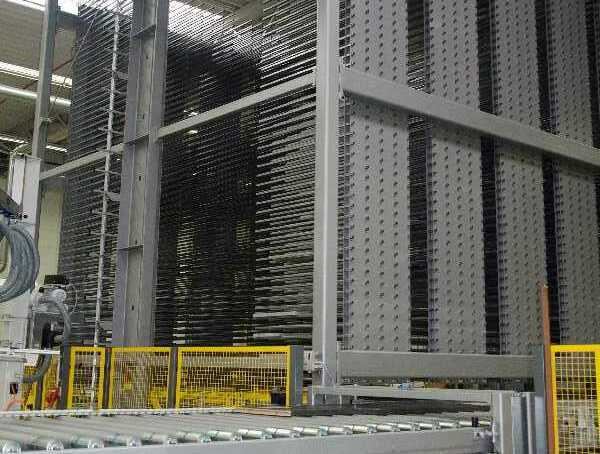
08.August 2013
NOLTE - Kitchens optimzes the material flow of the kitchen worktop production
 With a simple and manageable investment in the right place, the efficiency of the entire production can be significantly enhanced.
With a simple and manageable investment in the right place, the efficiency of the entire production can be significantly enhanced. In the course of establishing the 1-piece-production these systems become increasingly important for the production efficiency.
Increasing Manufacturing Efficiency
With the help of a sorting warehouse, the work piece will be temporarily stored between each individual processing step and is then made available just-in-time in a new optimised order for the following processing step.This does not only allows optimizing the production process when manufacturing furniture components, but also opens up entirely new possibilities to a more rational production.
First System was already 2000 in use at Nolte-Kitchens
 In 2000, SYSTRAPLAN had already delivered a simplified system to Nolte-Kitchen with the aim to separate the packaging of kitchen worktops from the production. The efficiency of the entire kitchen worktop production was significantly increased.
In 2000, SYSTRAPLAN had already delivered a simplified system to Nolte-Kitchen with the aim to separate the packaging of kitchen worktops from the production. The efficiency of the entire kitchen worktop production was significantly increased. New Concept ensures Optimizing through Sorting Warehouse
With the modernisation of the worktop production Nolte Kitchens continues to rely on well proven and more advanced technology. The new approach integrates two compact sorting warehouse blocks by SYSTRAPLAN, in order to optimize the production processes.According to the new concept one sorting block was positioned between cutting and the following edge banding machine or CNC processing. A further section was installed upstream of the packaging of the boards.
Aims of a Sorting System:
- Optimization of active processing times
- Optimization of resetting times
- Smoothing of production capacity
- A more constant production process, lot-size-1 provided
- Allowing several orders for the next shipping date as well as further orders of the same machine operation, so called “can-pieces” that are provided by the buffer at a later point in time
- Same manufacturing time for A-, B- and C-products
- Just-in-time feeding of processing machines directly from the sorting warehouse
- Best possible utilisation of the resources
- Minimisation of waste
The sorting warehouse operates respectively optimizes various tasks individually or in combination.
A production control system performs the stock administration, the management of the entire processes as well as the optimization based on the criteria individually defined.
The warehouse management and control system, part of the SYSTRAPLAN storage system, runs on a standard PC under the Microsoft operating system Windows.
High Mechanical Cycle Performance of Sorting Warehouse
 The mechanical cycle output of a sorting warehouse comes to approx. 3 cycles per minute. This means, at best, with assumed 6 separate sections on the operator unit that 3 by 6 parts per minute could be transported.
The mechanical cycle output of a sorting warehouse comes to approx. 3 cycles per minute. This means, at best, with assumed 6 separate sections on the operator unit that 3 by 6 parts per minute could be transported.The quantities that are to be stored within a warehouse and the required cycle times must be taken into consideration on the basis of part sizes, installation dimensions and weights in designing the system.
Example of a Compact Sorting Warehouse Block
Based on the usual working piece dimensions used in the furniture industry – that is approx. 1.000 x 500 mm -, one sorting warehouse has a capacity of max. 1.320 parts with a cantilever depth of approx. 1.300 mm and 6 sections with the appropriate length and approx. 55 levels on the left and right side of the operator unit, roughly corresponding to a hall height of ca. 6 m.When planning an efficient sorting system individual requirements are essential.
Advantages of a sorting system:
- Ideal flow of the work pieces right from the start
- Higher capacity utilization of processing machines
- Taking account of a plurality of production parameters
- Individual definition of sort criteria
- Resorting for the next processing step
- Storage, buffering and automatic batch forming
- Optimal packing density thanks to classification into sections and multi-deep storage
- Further sorting warehouses can be installed in a row
- Direct access to individual parts
- High mechanical performance
